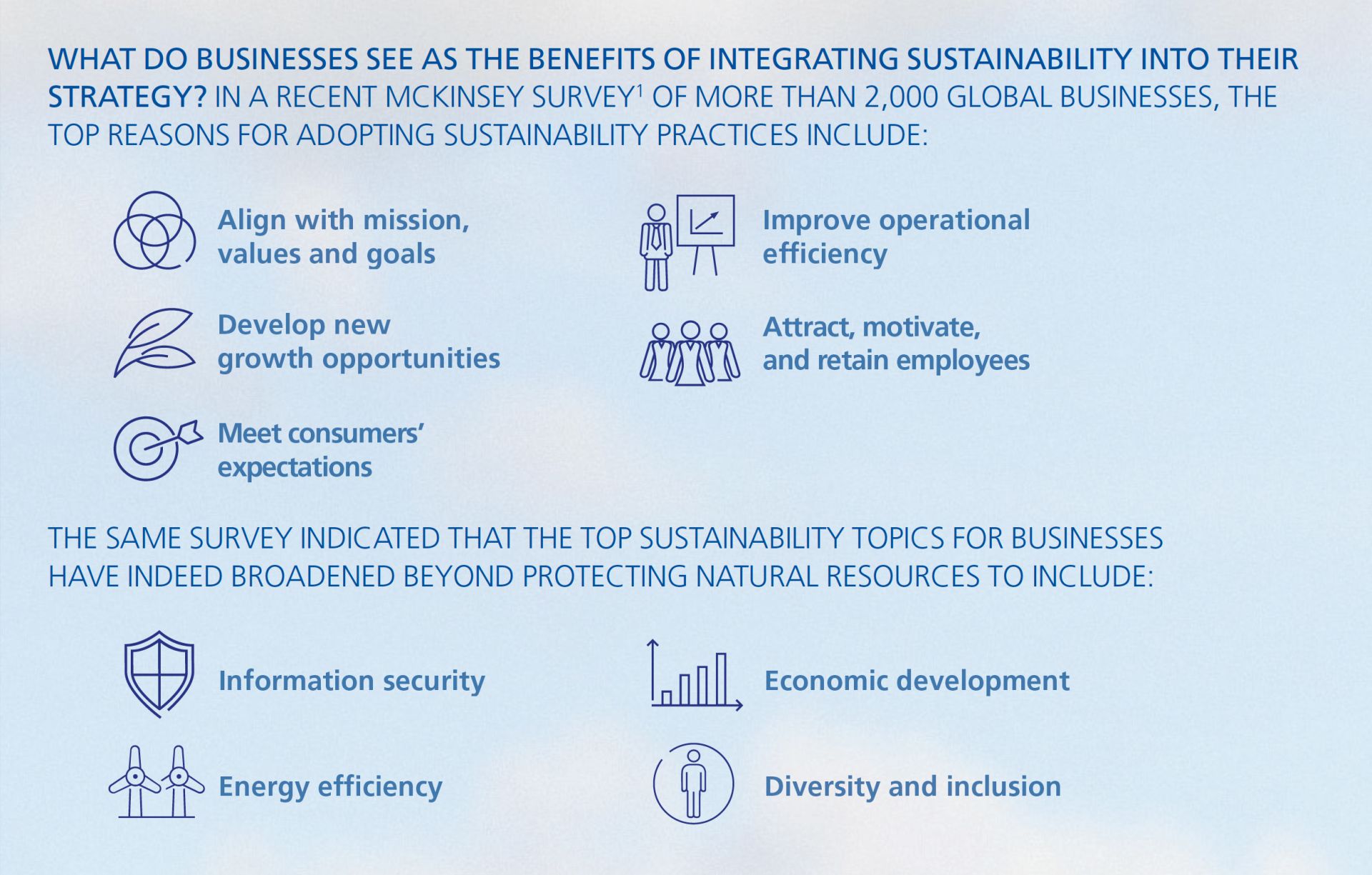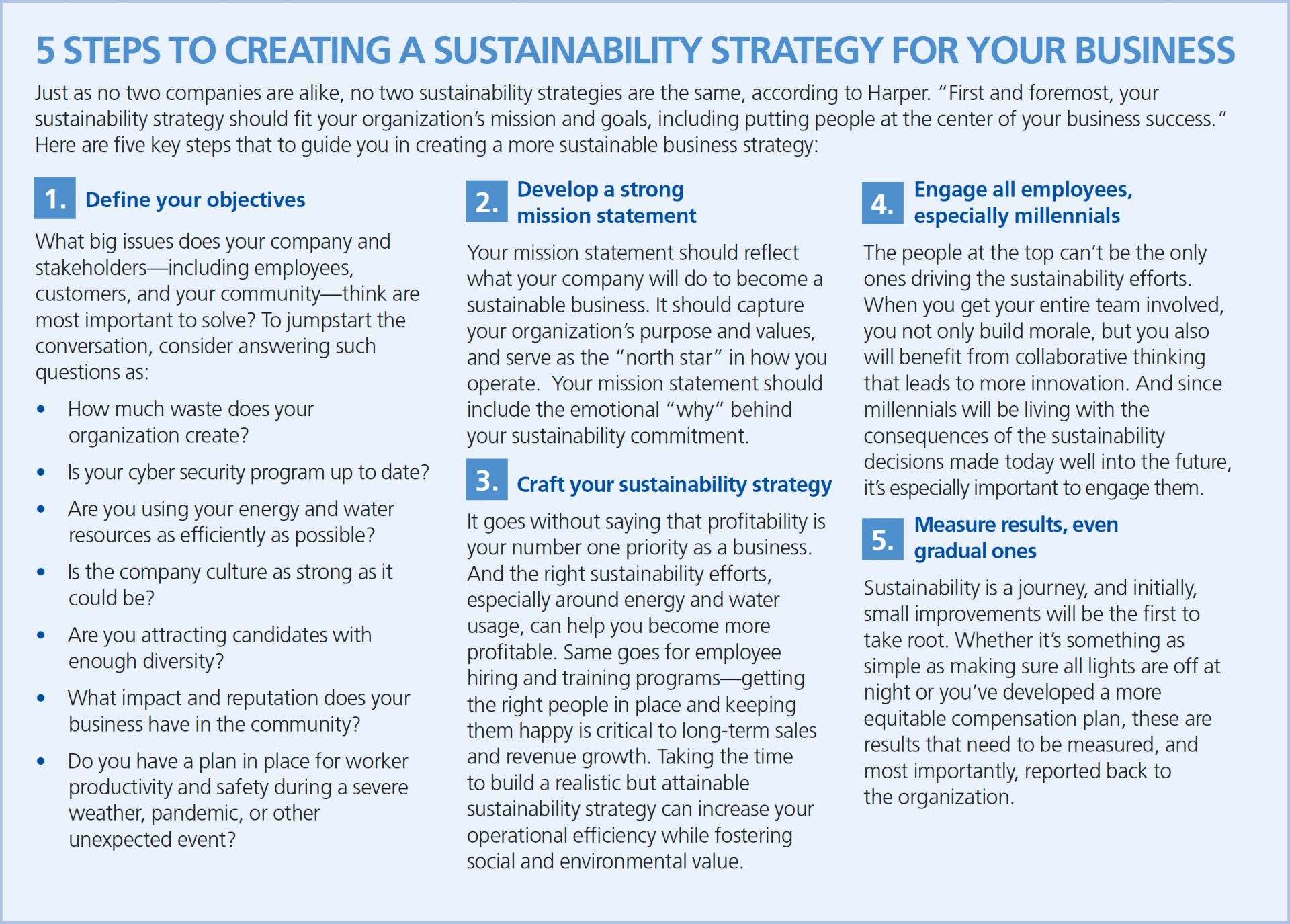SUSTAINABILITY
WHAT DO BUSINESSES SEE AS THE BENEFITS OF INTEGRATING SUSTAINABILITY INTO THEIR STRATEGY? IN A RECENT MCKINSEY SURVEY1 OF MORE THAN 2,000 GLOBAL BUSINESSES, THE TOP REASONS FOR ADOPTING SUSTAINABILITY PRACTICES INCLUDE:
THE SAME SURVEY INDICATED THAT THE TOP SUSTAINABILITY TOPICS FOR BUSINESSES HAVE INDEED BROADENED BEYOND PROTECTING NATURAL RESOURCES TO INCLUDE:
Why Sustainability and Risk Management Go Hand in Hand
Sustainability is a business term that seems to have as many definitions as there are organizations adopting it as a strategy. Starting in the 1980s, sustainability was used to describe how businesses thought about using natural resources more responsibly and to reduce negative impacts on the air, water and land. “Meeting the needs of today without comprising the future,” is how sustainability was defined for many organizations, explains Ben Harper, Head of Corporate Sustainability for Zurich North America. Materials recycling and high-efficiency water fixtures, for example, were early organizational sustainability efforts.
As the world began to face new and more severe environmental challenges such as climate change, as well as increasing social, economic, and technological challenges, the definition of sustainability evolved and expanded. Sustainability is now being considered as an umbrella term for an organization’s efforts to do “well for the business” but also “do good for society.” In September 2019, the Business Roundtable, a nonprofit association made up of CEOs from major American companies, made a major policy shift by declaring that the primary focus of business is not just to drive shareholder value, but to work in the interests of all stakeholders, including employees and communities. Many saw this statement as the business world’s full endorsement of sustainability and corporate social responsibility.


Align with mission, values and goals

Develop new growth opportunities

Meet consumers’ expectations

Improve operational efficiency

Attract, motivate, and retain employees

Information security

Energy efficiency

Economic development

Diversity and inclusion

Businesses across all industries see the range of benefits of adopting a sustainability strategy, such as improved brand image, attracting better talent, reducing costs, and increasing productivity,” says Zurich’s Harper. “But as unprecedented climate, geopolitical, and economic events occur that can catch businesses off-guard, sustainability also describes an organization’s resiliency to and recovery from these types of shocks.

SUSTAINABILITY AS A RISK MANAGEMENT STRATEGY
At first glance, sustainability and risk management seem to have different goals. Sustainability is often thought of as being more transformational by creating growth, innovation, and value for a company, while risk management operates more as a mitigator of issues around physical property, cyber security, worker safety, among others. More recently, businesses have begun to align sustainability and enterprise risk management strategies as a way to manage resources in the face of disruptive risks. The chief executive officer of the Sustainability Accounting Standards Board recently declared that “sustainability isn’t new; it is the new face of risk.”2
There’s no more prominent report on worldwide risks than the World Economic Forum (WEF) and their annual survey of 750 global business leaders and decision-makers. In its 2020 report, the WEF found that climate-related issues dominated the top five long-term risks.3 Climate change is seen as having severe financial, environmental, and social risks. “Recovery from the impact of a climate-related event can take a while before a business is whole again,” explains Harper. “For a business to remain economically sustainable in the face of climate-related issues, it requires having the right risk management tools in place, including insurance coverage.”
Aligning sustainability and risk management strategies helps businesses prioritize where to focus their efforts by looking at where business drivers and stakeholder priorities overlap. When sustainability and risk management work together, they can identify most clearly the true business risks, and develop more robust and effective goals, implementation plans, and accountability.

5 STEPS TO CREATING A SUSTAINABILITY STRATEGY FOR YOUR BUSINESS
Just as no two companies are alike, no two sustainability strategies are the same, according to Harper. “First and foremost, your sustainability strategy should fi t your organization’s mission and goals, including putting people at the center of your business success.” Here are five key steps that to guide you in creating a more sustainable business strategy:

Define your objectives
What big issues does your company and stakeholders—including employees, customers, and your community—think are most important to solve? To jumpstart the conversation, consider answering such questions as:
- How much waste does your organization create?
- Is your cyber security program up to date?
- Are you using your energy and water resources as efficiently as possible?
- Is the company culture as strong as it could be?
- Are you attracting candidates with enough diversity?
- What impact and reputation does your business have in the community?
- Do you have a plan in place for worker productivity and safety during a severe weather, pandemic, or other unexpected event?

Develop a strong mission statement
Your mission statement should reflect what your company will do to become a sustainable business. It should capture your organization’s purpose and values, and serve as the “north star” in how you operate. Your mission statement should include the emotional “why” behind your sustainability commitment.

Craft your sustainability strategy
It goes without saying that profitability is your number one priority as a business. And the right sustainability efforts, especially around energy and water usage, can help you become more profitable. Same goes for employee hiring and training programs—getting the right people in place and keeping them happy is critical to long-term sales and revenue growth. Taking the time to build a realistic but attainable sustainability strategy can increase your operational efficiency while fostering social and environmental value.

Engage all employees, especially millennials
The people at the top can’t be the only ones driving the sustainability efforts. When you get your entire team involved, you not only build morale, but you also will benefit from collaborative thinking that leads to more innovation. And since millennials will be living with the consequences of the sustainability decisions made today well into the future, it’s especially important to engage them.

Measure results, even gradual ones
Sustainability is a journey, and initially, small improvements will be the first to take root. Whether it’s something as simple as making sure all lights are off at night or you’ve developed a more equitable compensation plan, these are results that need to be measured, and most importantly, reported back to the organization.
THE BOTTOM LINE, TRIPLED
Every successful business leader needs to deliver on the bottom line and create profits for the organization. Sustainable business leaders measure the bottom line along with two additional performance areas: people and planet.
People includes employees, any labor involved in performing your company’s work such as vendors and subcontractors, and the wider community where you do business. A Triple Bottom Line company pays fair wages to employees and gives back to the community, through efforts like funding local education programs or donating to the construction of a new park.
Planet refers to a business reducing its environmental footprint as much as possible, whether it’s reducing waste, investing in renewable energy, or being more efficient with transportation logistics.
The Triple Bottom Line concept has been around for several decades, but still remains one of the clearest ways for any organization to monitor and measure their sustainability efforts.
THE TRIPLE BOTTOM LINE: PEOPLE, PLANET, PROFIT

SUSTAINABILITY PROVIDES AGILITY FOR THE FUTURE
No one can see into the future what potential consequences can come from climate change, disruptive technologies, or supply change. A dynamic sustainable strategy that is aligned with risk management practices can give a business more agility to seize growth opportunities while creating resiliency for unexpected changes. “It’s difficult to plan for something we don’t know will happen, but we do know that sustainability leads to resiliency, which will shield a business from economic challenges,” concludes Harper.
SUSTAINABLE BUSINESS RESOURCES:
American Society of Civil Engineers
ASCE is dedicated to ensuring a sustainable future in which human society has the capacity and opportunity to maintain and improve its quality of life indefinitely, without degrading the quantity, quality or the availability of natural, economic and social resources. Discover their extensive sustainability resources at asce.org/sustainability.
The American Sustainable Business Council
This organization serves the public policy interests of responsible companies, their customers and other stakeholders. Read more about the High Road Economy at asbcouncil. asbcouncil.org.
Ceres
Ceres is a sustainability nonprofit organization working with the most influential investors and companies to build leadership and drive solutions throughout the economy. View their Sustainability Roadmap at ceres.org/roadmap.
World Business Council for Sustainable Development
A global, CEO-led organization of over 200 leading businesses and partners working together to accelerate the transition to a sustainable world. Learn more about its work at wbcsd.org.

8 DEALER PRINCIPAL